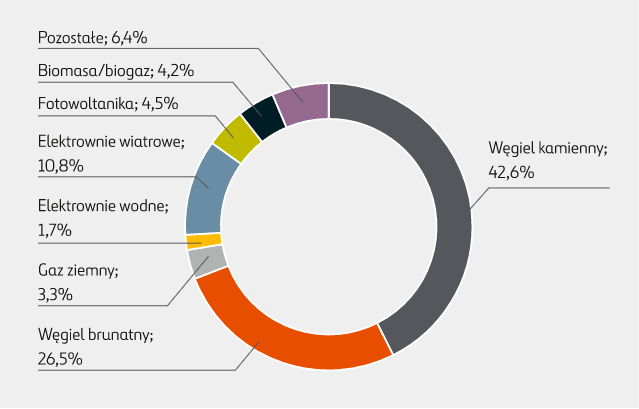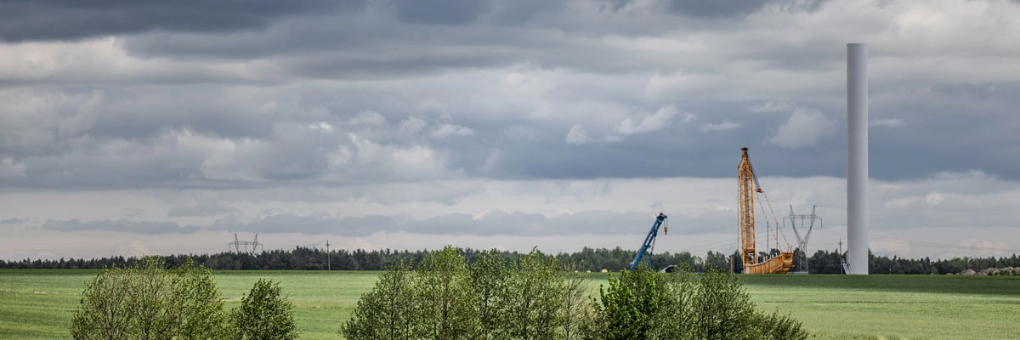Three segments can be distinguished on the energy construction market:
- transmission and distribution of electricity;
- generation of electricity;
- transmission and distribution of gas.
The size and structure of energy projects are determined by Poland’s energy policy. In February 2021, the Council of Ministers adopted the Energy Policy of Poland until 2040 (PEP 2040). The document sets directions for the development of the energy sector.
The strategy is to be based on three pillars of a fair transition for all regions, a zero-carbon energy system and good air quality. In terms of the energy mix, it sets out the goal for achieving the following indicators in 2030:
- no more than 56% of coal in electricity generation;
- at least 23% of RES in gross final energy consumption.
Greenhouse gas emissions should fall by 30% by 2023 compared to the 1990 levels.
Energy mix in Poland in 2022

Poland is currently facing the challenge of phasing out the oldest coal-fired power units. The activities of companies in the sector are focused on the implementation of projects aimed at climate neutrality. PGE is preparing the project of the largest offshore wind farm in the Baltic Sea and is working on the construction of two CCGT units at the Dolna Odra Power Plant. Another important event in the energy sector is the merger of Orlen, Lotos and PGNiG. The creation of a multi-energy group of companies is an unprecedented event on the domestic market, which may change the balance of power on the map of Europe’s energy interests.
The Energy Policy of Poland until 2040 assumes that the first nuclear power plant in Poland will be built by 2033. In 2021, it was decided that it will be located in Lubiatowo-Kopalino in the Choczewo gmina (Wejherowo poviat, Pomorskie wojewodztwo).
In 2033, it is planned to commission the first unit of the nuclear power plant with a capacity of approximately 1–1.6 GW. Subsequent units will be commissioned every 2–3 years, and the entire programme assumes the construction of 6 units. In 2022, the Council of Ministers selected the supplier of reactors for the first Polish nuclear power plant – Westinghouse, an American company. At the end of October 2022, ZE PAK signed a letter of intent with Polska Grupa Energetyczna and KHNP, a Korean company, on partnerships in exploring the possibility of constructing a nuclear power plant in Poland. The power plant is to be constructed in Pątnów, where the ZE PAK lignite-fired power plant is currently located.
Na polskim rynku wciąż pojawia się niewiele przetargów w formule PPP na inwestycje o znacznej wartości.

Small nuclear power plants are becoming increasingly popular among Polish companies. In 2021, the first two contracts were signed for the construction of modern small, modular nuclear power plants. In 2022, the Enea Group signed a letter of intent with an American company, Last Energy, on working in the field of SMR.
The PEP 2040 assumes the construction of offshore power plants with a capacity of 5.9 GW by 2030. The applicable Act of 20 May 2016 on projects related to wind farms introduced one of the most restrictive distance rules in Europe – known as the 10H rule, i.e. ten times the height of the wind farm as the minimum distance between any new project and the existing residential buildings and forms of nature conservation. It was a response to social dissatisfaction in some parts of the country related to the rapid development of power plants. It resulted in limiting the possibility of locating new plants and initiating wind farm projects, as well as blocking the development of residential construction in the vicinity of the existing power plants. In 2022, despite the government’s work on amending this act, it was not possible to unlock the development of wind farms in Poland.
In connection with Russia’s aggression against Ukraine, on 29 March 2022 the Council of Ministers adopted assumptions for updating Poland’s Energy Policy until 2040. The amended energy policy for Poland will take into account the fourth pillar – energy sovereignty, the special element of which to ensure the rapid independence of the national economy from the import of fossil fuels from Russia.
Compared to previous forecasts, the policy in its current form assumes that gas consumption in power plants and combined heat and power plants will be reduced by about 37% by 2030 and about 45% by 2040.
According to the provisions of PEP 2040, RES are to have a 50% share in electricity production. The strategy also mentions 23% of energy from nuclear energy, new capacities of 7.8 GW from large nuclear power plants and the development of SMR in the future. The construction of the FSRU, a gas floating terminal in the Gulf of Gdańsk, is to be accelerated along with the expansion of the national network and underground natural gas storage facilities.
In November 2022, the President of the Energy Regulatory Office agreed on the “Development plan to satisfy the current and future electricity demand” for 2023–2032 (Transmission System Development Plan). According to this document, the value of projects in the transmission network in 2023–2032 will amount to PLN 36 billion. The plans include the construction of 600 kilometres of an HV DC line to enable the transmission of energy from the north of the country, generated in onshore and offshore wind sources, to the south. The transmission network should also enable the connection and power output from a nuclear power plant in the location currently preferred by Polskie Elektrownie Jądrowe. The projects presented in the PRSP are intended to support Poland’s commitments to achieving the national target in terms of the share of energy from RES in final energy consumption, the government plan to build offshore wind farms in the Baltic Sea, the government plan to build nuclear power capacity, and the connection of new generating units in accordance with the results of capacity market auctions for 2023–2026.

